COMPLETE Kitchen transformation, from top to bottom!
My husband and I should really be happy that our kitchen was as horrible as it was when we bought the house. First of all, the lack of an updated kitchen (ie, cherry cabinetry/granite countertops/stainless steel appliances nowhere in sight) really scared away other buyers, kept the price of the house low, and allowed us to gut the entire thing without shame.
The room was situated as follows:
The East-facing wall, which looks out over our backyard, was particularly claustophobic, with floor-to-ceiling cabinetry that actually extended over the top of the window :
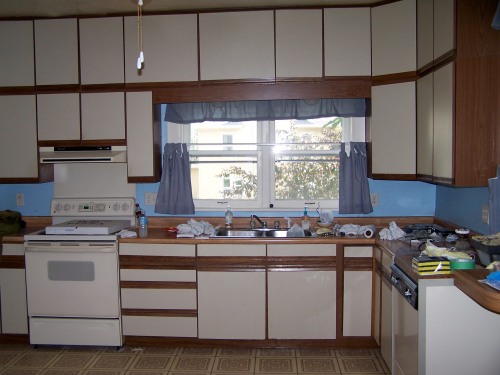
Parsonage kitchen, looking East, before move-in.
The North wall, which holds the doorway to a half bath (right side) and landing to the basement (left side) continued the “sea of beige” theme:
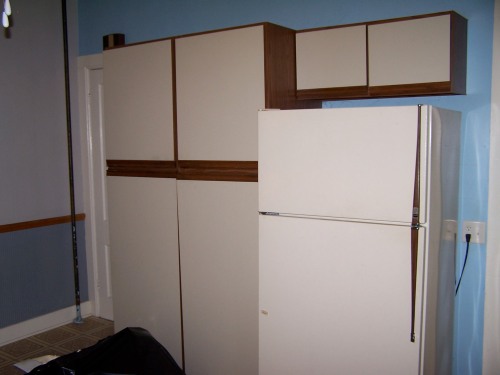
North wall, prior to move-in.
The West wall, which opens up to the parlor, was papered with two different shades of blue- flowers above a chair rail, stripes below. The paper clashed horribly with the country blue paint elsewhere in the kitchen, and only stayed for about a week after closing:
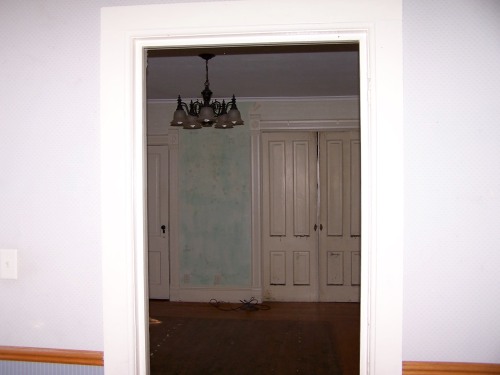
West wall, overlooking parlor, before move-in.
The South wall holds the door to the sunporch, a huge radiator (covered with a fake wood cap to match the countertops), and was largely covered with floor-to-ceiling corkboard. The North Wall picture above shows the old cabinetry and rolling dishwasher to the immediate left of the radiator. The wall also holds a beautiful arched window original to the house. Unfortunately, the window was almost entirely blocked by the rolling dishwasher and drapes, and couldn’t be opened up to the porch outside because a shelf had been built into the top sash. 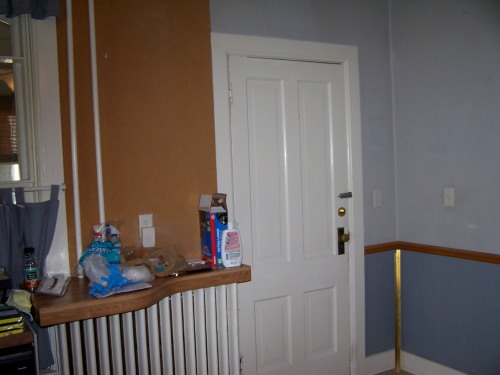
South wall, before move-in.
Now, up to this point, I’d agree that the kitchen was pretty bland- and that the previous owners could have done a lot worse. There are a few harvest gold and avocado-colored appliances in the basement that give insight into previous kitchen remodels that were likely much uglier. But let me, at this point, introduce you to the floor:
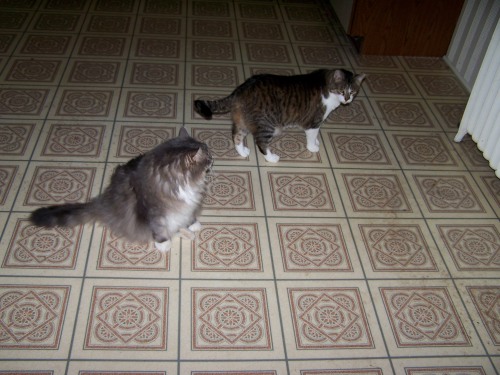
Our cats Abner (left) and Bill (right) on the kitchen floor.
This red, blue, beige and orange pattern covered the entire floor of the kitchen, extending into the half bath (where it was even more atrocious, being in a smaller space), and onto the basement stairs. In addition to being just plain ugly, the floor was also impossible to clean. The lineoleum had a pitted texture that held all of the dirt brought in by dogs, cats and workmen (not to mention the dust and grime that had settled in the time the house was vacant). We tried mopping and scrubbing and bleaching, to no avail. We lived with this floor until about a month ago when it was finally, mercifully, ripped out.
Such was the kitchen as we knew it.
Since I started the account of the kitchen renovation a little late, I’m behind on posting what the kitchen looks like now. It is vastly different from where it started, and even more so than when it was demolished.
Our kitchen had a few surprises for us during demolition. Largely, we found out that the wiring, which we had thought was all up to code (as it was a condition of our purchase on the house), had to be completely replaced. Apparently the terms of our purchase agreement had stated that all knob and tube wiring in the house needed to be brought up to code. Since the kitchen wiring was no longer knob and tube, it did not fall under this provision. Even with the update, it still needed about $1,000 more to be brought fully up to code.
A second surprise was a hidden built-in on the North Wall, which came to light after the large cabinet was ripped out. John and I always thought it was just poor planning that left the large space between the kitchen and the back landing shelves unused- but as it turns out, this space was occupied by this lovely wallpapered shelf:
The shelf contained cinnamon sticks, toothpicks, and old glass pill bottle, and the ubituitous paper-towel holder. My house, at one point, contained at least ten of these paper-towel holders- hung in the basement, the shop, the carriage house, and on the backs of kitchen cabinets. It was a bit of a joke to us that we would uncover another one here.
As this wall is slated to hold our custom-made Hoosier cabinet, we are thankful that the built-in is not worth keeping.
Another surprise was the floor. We had been hoping that the underlying floor would be a continuation of those on the rest of the first floor- maple with stair-stepped corners and center inlays. We were optimistic that it would be, since the room was likely not used as a kitchen originally. In tearing up the top layer and its subfloor, we found we actually had several layers of linoleum to contend with:
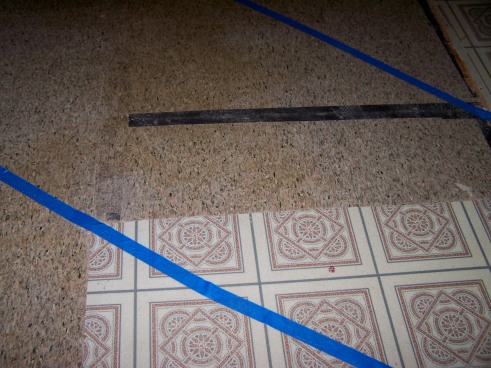
Linoleum layers #1 and #2.
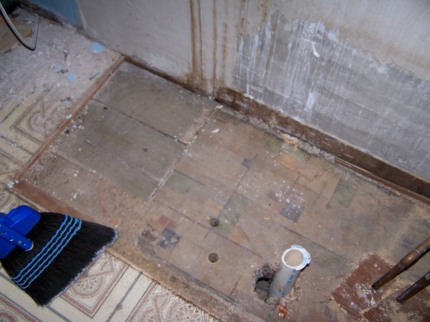
Floor layer #3, century-old linoleum.
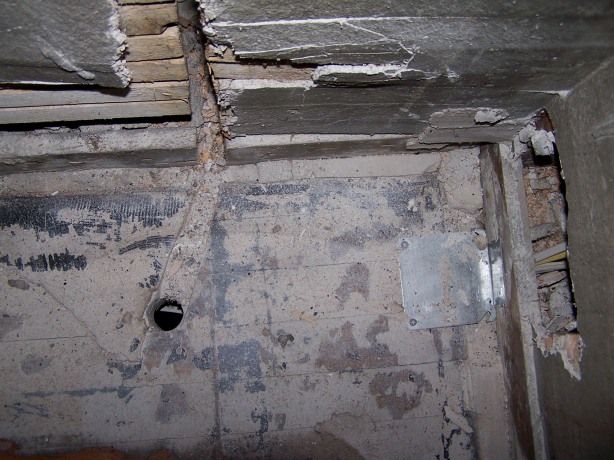
Exposed wood floor, with adhesive.
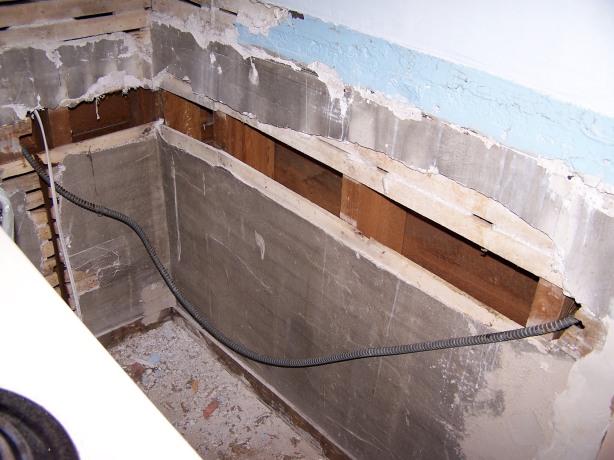
Gaping hole, East and South walls.
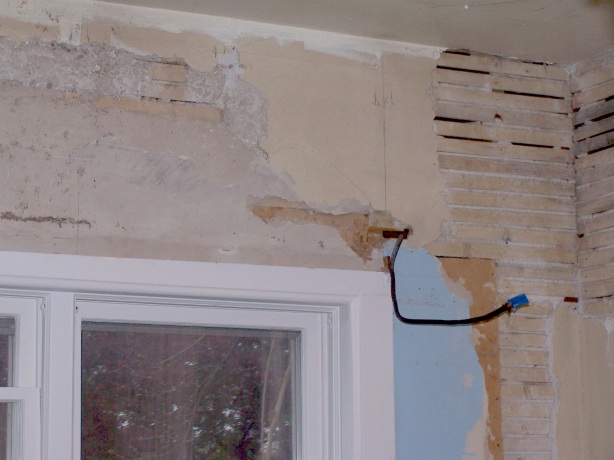
East wall, near ceiling.
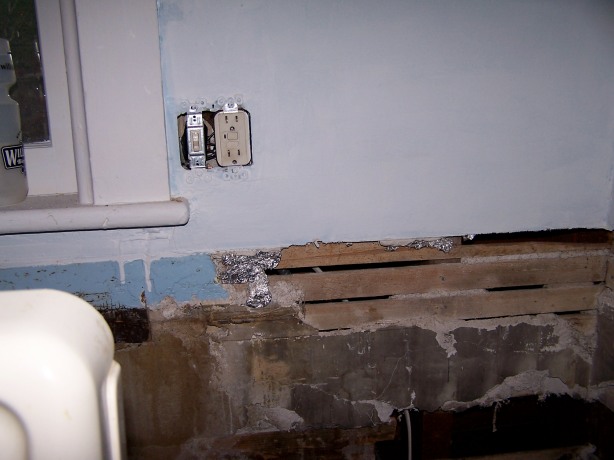
Tinfoil patch.
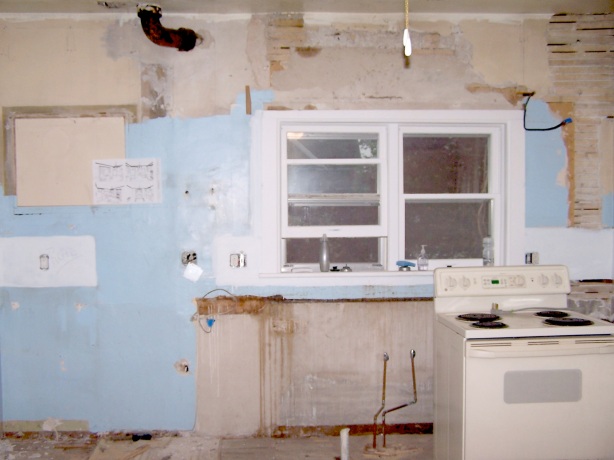
Massive rusty old pipe!
The most frustrating thing about a kitchen remodel are those days when you come home from work and find that absolutely nothing has been done, and it’s been a week since anything happened, and even when it did it was just a hole drilled to fit the radiator pipe, and you’ve been two months without an oven and you can’t have anything more sophisticated than a lean cuisine and a pudding cup for dinner. You can’t take advantage of the thousands of ripe mulberries on the trees outside or the massive rhubarb plants in the backyard because all you have is a microwave and plastic silverware. But you tell yourself that soon you will have the kitchen of your dreams with enough oven space to make 96 cupcakes in one batch, and enough counter space to fit them all.
The best thing about a kitchen remodel are the days when you come home from work and find that some progress has been made. Here is a montage of our best days. I’ll leave it to your imagination to set the music.
It all started with paint. We chose a bright white trim and a cool blue color for the walls, as the utility rooms and functional spaces of Victorian homes were often painted or papered in light blue or grey:
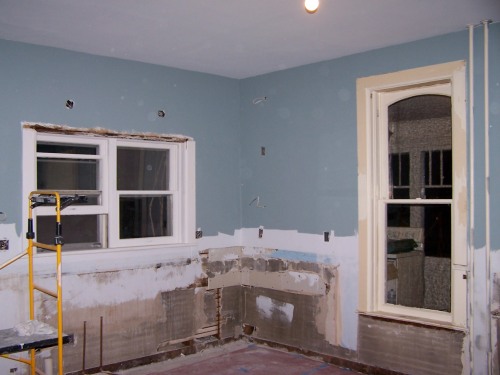
East and West walls, trim scraped and first coat of paint on the walls.
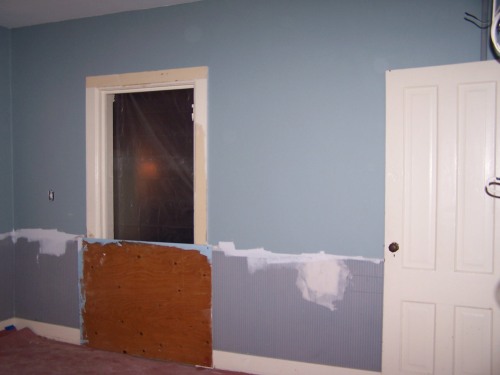
West wall, trim scraped and first coat above beadboard line.
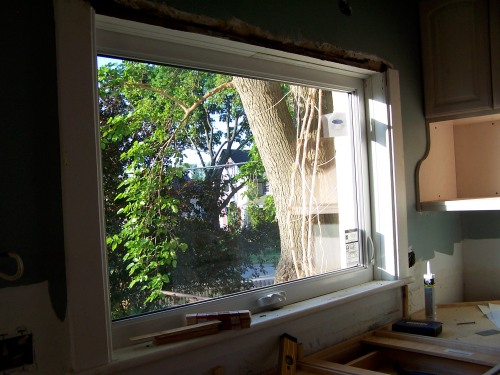
New window, overlooking the backyard.
Then came the floors! We were not quite sure what was going to be underneath all those layers of linoleum. John and I were hoping that the maple on the rest of the first floor of the house would continue into the kitchen area. We were also hoping that if it did, it would have been protected from major damage by the layers on top of it, and not too mangled by adhesive or nails. When we did finally get down through the three layers of linoleum and subfloor, we found this:
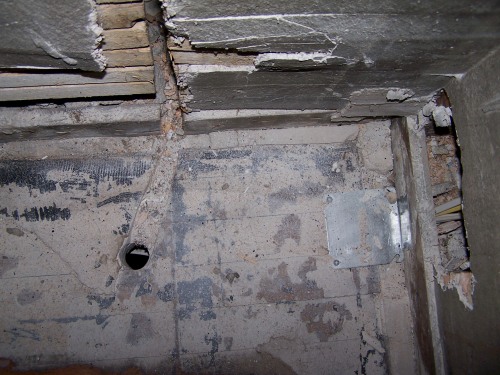
Adhesive!
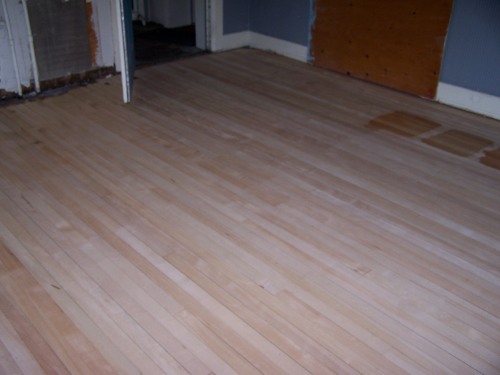
The original flooring, revealed.
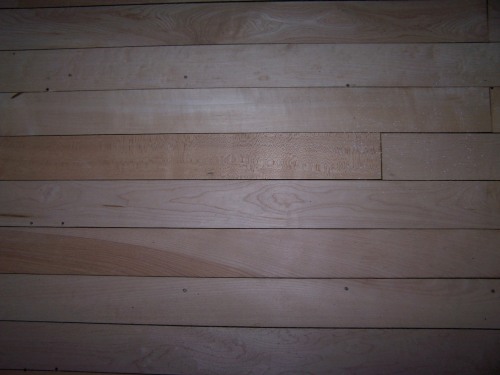
A close up of the sanded floor.
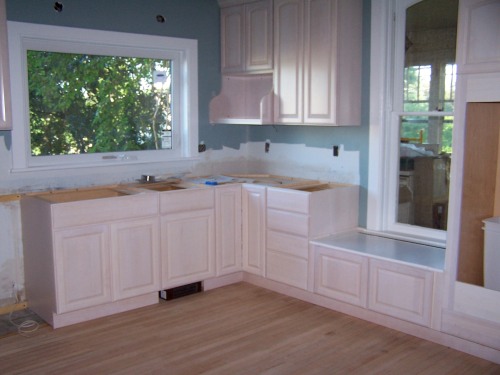
East and South wall, with uppers, lowers and window seat. Cabinetry continues to the left of the frame to include another upper and refrigerator enclosure.
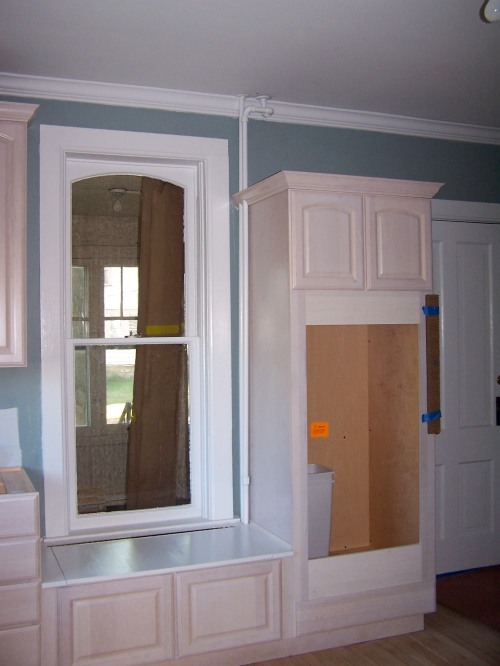
South wall, overlooking the sunporch. Windowseat and double oven enclosure. No more radiator and dishwasher on wheels!
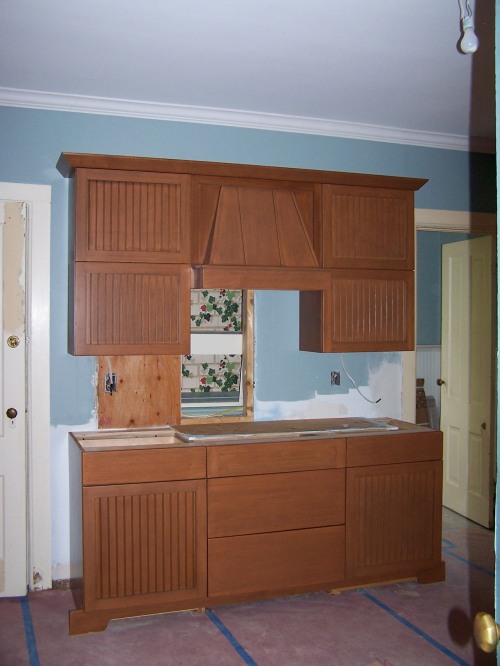
Hoosier, without the bells & whistles.
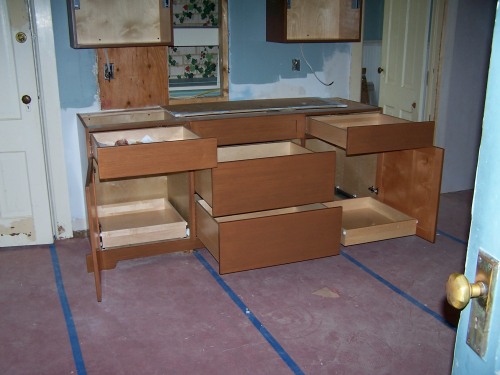
Lower portion of the Hoosier.
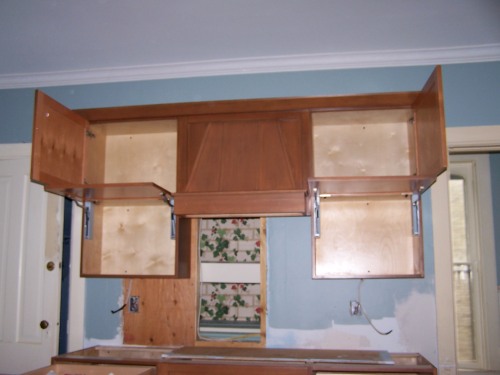
Hoosier cabinet uppers. Photo not stretched- it really is that wide!
Finally, we are nearing the close of the kitchen remodel! We are now just waiting for a few things to be finished- a hood fan and light needs to be installed over the cooktop, the backsplash for the Hoosier cabinet needs to be installed, and we need smaller screws for the pull knobs on the maple cabinets. The past few weeks have seen a flurry of activity in the kitchen, so let’s catch you up to where we are now!
As of the last post, we only had the bare bones cabinets in. A lot has happened since then- and you can really begin to see a variety of different materials and finishes. We were pretty bold (for us, anyway) in choosing different woods, countertops and finishes to create three different looks: the light maple cabinetry with dark soapstone counters, the Hoosier piece, and a marble-topped worktable. We really wanted to stay away from a more modern kitchen aesthetic, where everything tends to match. It was a challenge to keep everything cohesive, yet different enough to stand on it’s own.
I’ll start with the light cabinets. As I have said, we were really not sure how we felt about these, even after they were installed. As the accoutrements gradually made their way into the kitchen, however, we couldn’t be happier with them:
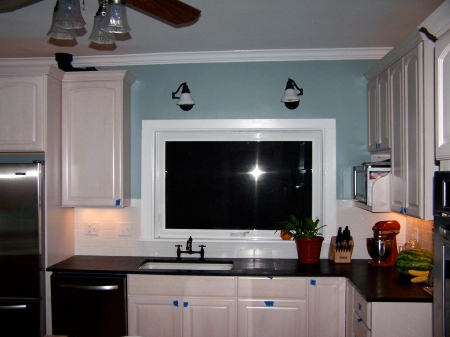
East wall. Still needs cabinet hardware and over-fridge trim piece.
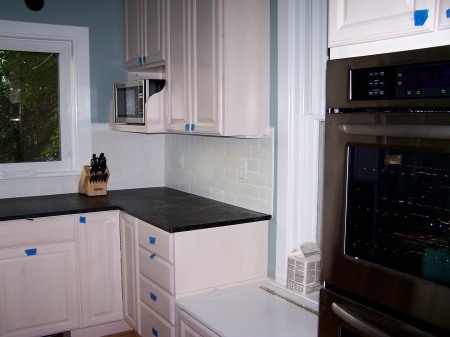 They also happen to hold two of my favorite things in the entire kitchen:
They also happen to hold two of my favorite things in the entire kitchen:
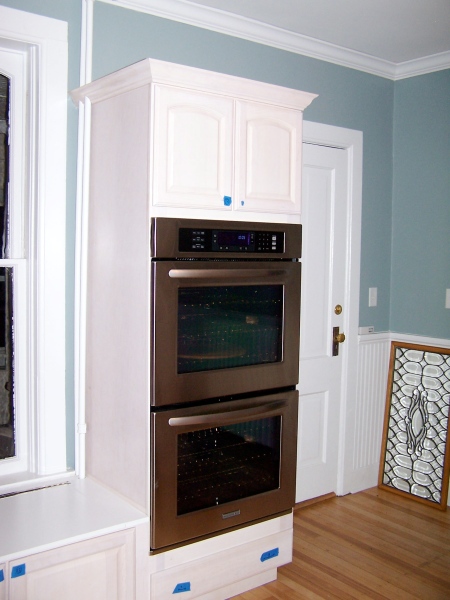 Those are my KitchenAid series ovens. They are both convection-capable, and have an absolutely stunning blue ceramic interior.
You know how people often include gratuitous shots of their children in their house blog? Well, I have gratuitous shots of my ovens:
Those are my KitchenAid series ovens. They are both convection-capable, and have an absolutely stunning blue ceramic interior.
You know how people often include gratuitous shots of their children in their house blog? Well, I have gratuitous shots of my ovens:
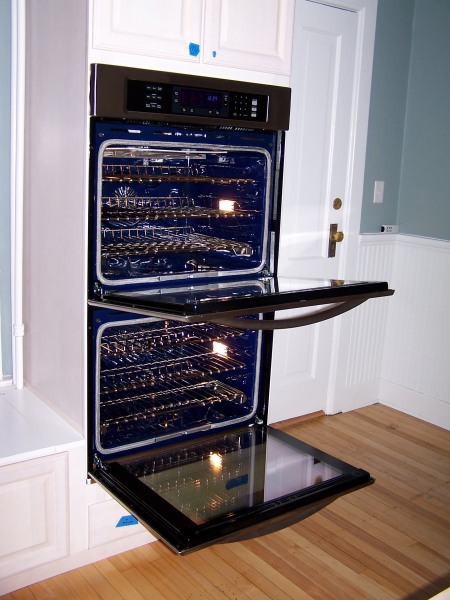
Side view #1.
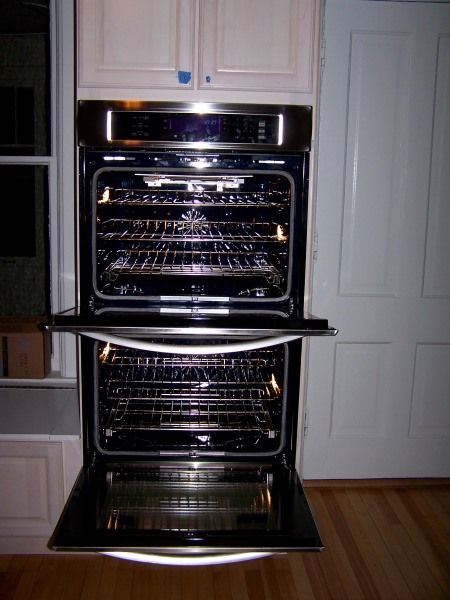
Front view.
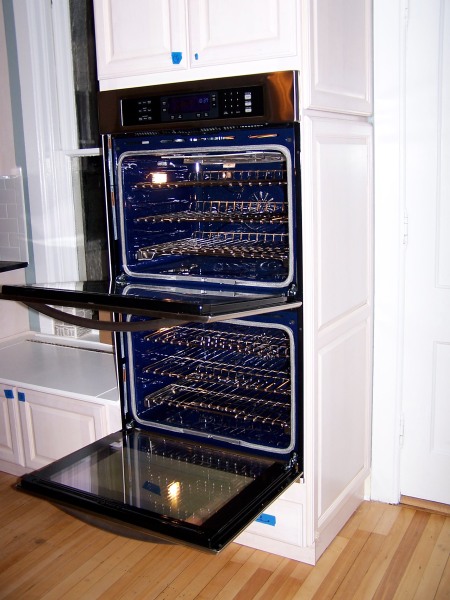
Side view #2. Look how pretty!
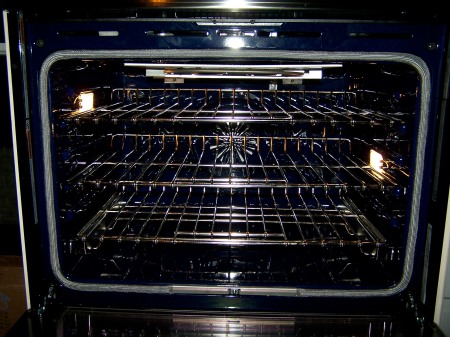
Close up of interior.
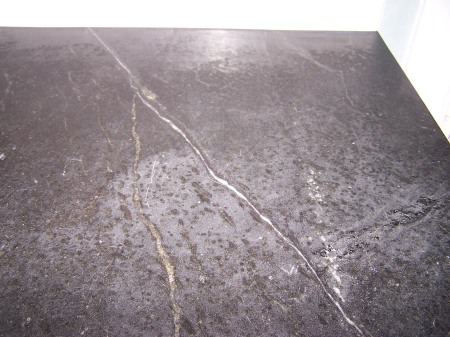
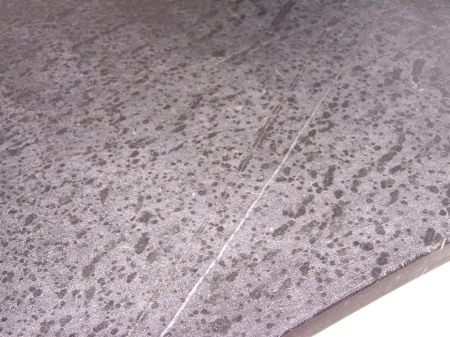 Now, there was a bit of drama at the countertop point of the remodel. When we got home from work on the day of the countertop install, we were absolutely horrified by what we found. This was a really big day for us, as it had been at least a month since any major work had been done in the kitchen. We were so excited to see the changes that had been made. That was, until we saw them.
First, the soapstone had a major crack in it at one of the weak points, where it was cut to fit the sink. It looked to our untrained eyes as though the countertop had been broken/cracked in transit and installed despite the crack. Not happy.
The marble topped work table, which I haven’t talked about too much yet, had quartz installed on it! QUARTZ. Sparkly white quartz. The string of expletives out of my husband’s mouth were not fit to be repeated here, but suffice it to say that I agreed completely with his assessment of the situation. Quartz has no business in our kitchen.
Did I mention that we are also remodeling both our bathrooms at the same time as the kitchen? Well, we are, because we are either a. stupid (to be without a kitchen entirely, and have only partial use of our bathrooms- ie, a functioning shower upstairs but no sink or toilet, functioning toilet downstairs but no shower) or b. wise (to be adding the equity or our house in one fell swoop). To get back to the horror story, on the same day referenced above, our bathroom downstairs (which we believe was once a butler’s pantry that was re-done at some point into a half-bath) had the incorrect floor laid. We wanted white hexagon tiles with black mosaic inlays for the floor- we got all white hexagon with no black tiles.
After my husband’s cool head prevailed and he was able to leave professional yet ornery voicemails on our project manager and designer’s phones, and send them a slightly snarkier e-mail, all was resolved, post-haste.
First, the countertop was not cracked. Soapstone, we learned, has fissures that naturally occur on the surface, which get filled in at the processing plants with white epoxy. Let me say that again- they fill them in with white epoxy. So if you have a dark gray countertop, as we do, white epoxy isn’t hiding the fissure as much as exposing it for all to see. Needless to say, the next working day we had someone come out and custom blend an epoxy to match the countertop- free of charge. Now the fissure looks like any of the other veins on the counter.
The Quartz situation was not as easy to remedy. Turns out that the countertop was actually not quartz at all, but a kind of marble known as Thassos marble. Our designer ordered Thassos marble rather than Carrera marble, because she thought they were the same thing. Here is a comparison of the two:
Now, there was a bit of drama at the countertop point of the remodel. When we got home from work on the day of the countertop install, we were absolutely horrified by what we found. This was a really big day for us, as it had been at least a month since any major work had been done in the kitchen. We were so excited to see the changes that had been made. That was, until we saw them.
First, the soapstone had a major crack in it at one of the weak points, where it was cut to fit the sink. It looked to our untrained eyes as though the countertop had been broken/cracked in transit and installed despite the crack. Not happy.
The marble topped work table, which I haven’t talked about too much yet, had quartz installed on it! QUARTZ. Sparkly white quartz. The string of expletives out of my husband’s mouth were not fit to be repeated here, but suffice it to say that I agreed completely with his assessment of the situation. Quartz has no business in our kitchen.
Did I mention that we are also remodeling both our bathrooms at the same time as the kitchen? Well, we are, because we are either a. stupid (to be without a kitchen entirely, and have only partial use of our bathrooms- ie, a functioning shower upstairs but no sink or toilet, functioning toilet downstairs but no shower) or b. wise (to be adding the equity or our house in one fell swoop). To get back to the horror story, on the same day referenced above, our bathroom downstairs (which we believe was once a butler’s pantry that was re-done at some point into a half-bath) had the incorrect floor laid. We wanted white hexagon tiles with black mosaic inlays for the floor- we got all white hexagon with no black tiles.
After my husband’s cool head prevailed and he was able to leave professional yet ornery voicemails on our project manager and designer’s phones, and send them a slightly snarkier e-mail, all was resolved, post-haste.
First, the countertop was not cracked. Soapstone, we learned, has fissures that naturally occur on the surface, which get filled in at the processing plants with white epoxy. Let me say that again- they fill them in with white epoxy. So if you have a dark gray countertop, as we do, white epoxy isn’t hiding the fissure as much as exposing it for all to see. Needless to say, the next working day we had someone come out and custom blend an epoxy to match the countertop- free of charge. Now the fissure looks like any of the other veins on the counter.
The Quartz situation was not as easy to remedy. Turns out that the countertop was actually not quartz at all, but a kind of marble known as Thassos marble. Our designer ordered Thassos marble rather than Carrera marble, because she thought they were the same thing. Here is a comparison of the two:
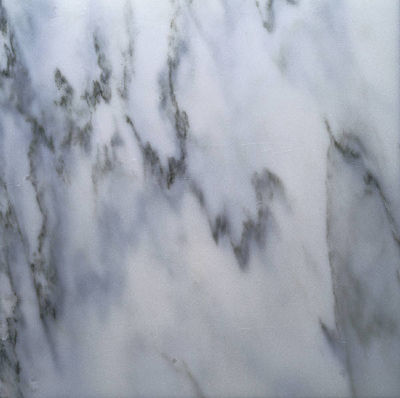
Carrera marble. It's what I think of, when I think of marble.
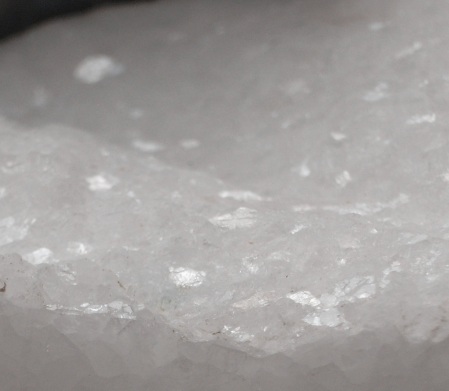
Thassos marble. Unprocessed- but the best way to see how sparkly it was.
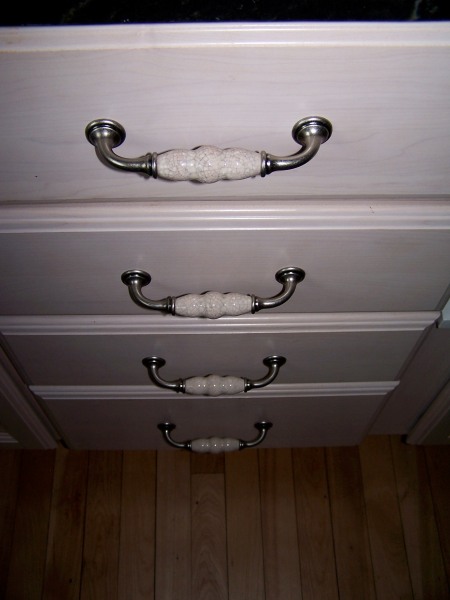
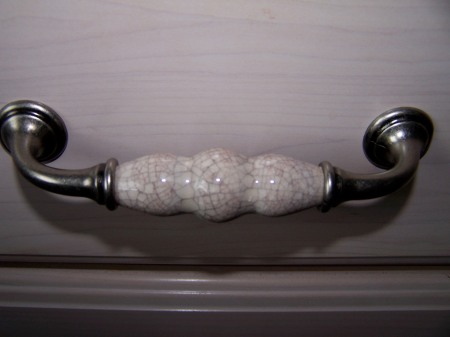
Beautiful!
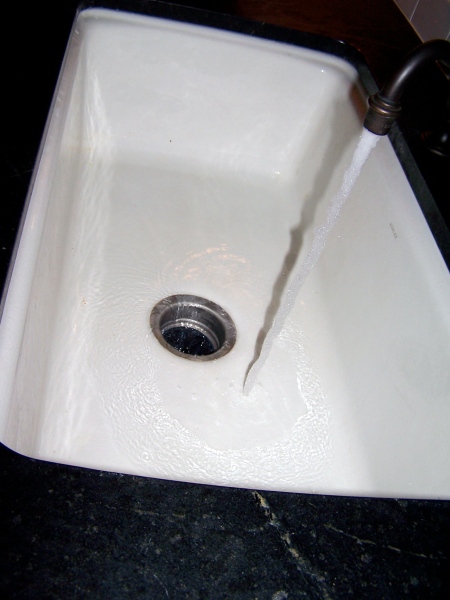
Sink closeup #1
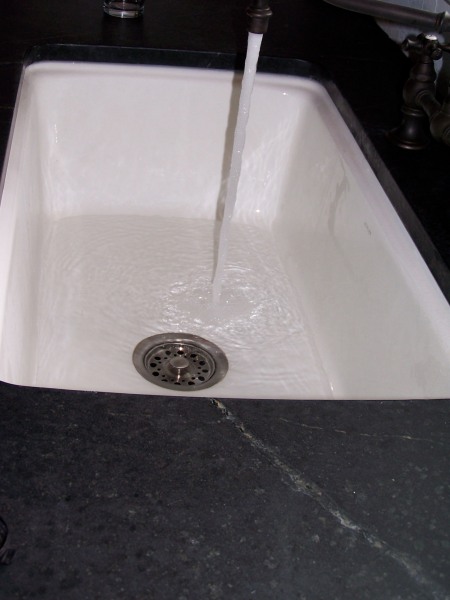
Sink closeup #2
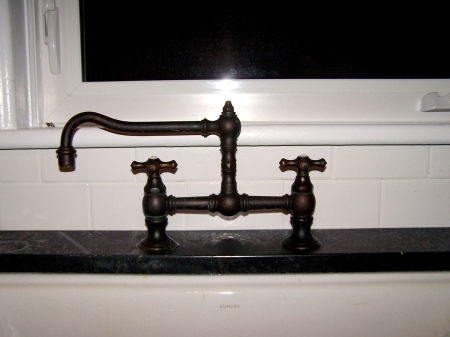
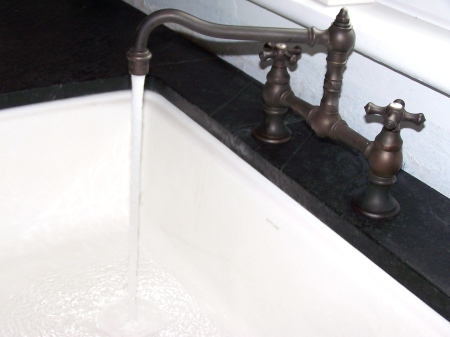
Faucet closeup.
A happy ending to a very, very long project.
The kitchen is done.
John and I still have to hang a few shelves and figure out where in the heck all of our kitchen bric-a-brac is going to go, but for all intents and purposes, the kitchen is done.
For the longest time, we were really just waiting for the Hoosier cabinet to be finished. We had the bare bones cabinet for a while, but were missing the beadboard and tile backsplash- partly because our designer forgot to order the extra beadboard, and partly because my husband had to perform the miracle of refinishing this old tin ceiling tile for the center:
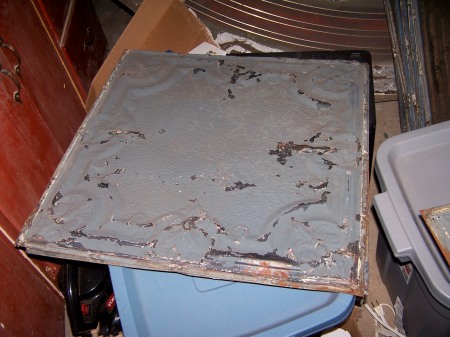
I know it doesn’t really look like much there, but underneath those thick layers of paint is something worth rescuing. We found this little gem, along with several others from the same ceiling (including some fantastic long vertical ones with central fleur-de-lis) at the Restoration Warehouse/Restoration Trust in Dubuque, Iowa. For those of you unfamiliar with it, the Restoration Warehouse is pretty much mecca for old house nerds like us. They have everything you could possibly need for your restoration project- cabinet pulls, door knobs and hinges, lighting fixtures, mantelpieces, wrought iron fences, plaster and lathe, carved stone pavers, doors, sinks, bathtubs, faucets, stoves, radiators, cabinetry, windows, ceiling tiles, furniture, and even entire staircases. It is a bittersweet feeling as you walk through and marvel at these beautiful and intricate forgotten things, imagining the estates that they used to belong to. You can only guess at the grandeur of these former places, as they’ve likely been torn down years ago to make way for the new. In the warehouse, you pick through the pieces of these magnificent old houses, each object a waiting for someone to come along and shine it up and restore it to its former beauty. Such was the case with our ceiling tile.
After many nights spent in the basement shop scraping, applying paint stripper, scraping some more, stripping some more, and selectively applying a creative finish that only my husband could have thought of (we have certainly gotten crafty with temperature-resistant spray paint), my husband revealed this:
Amazing!
Here are a few shots of the finished Hoosier cabinet:
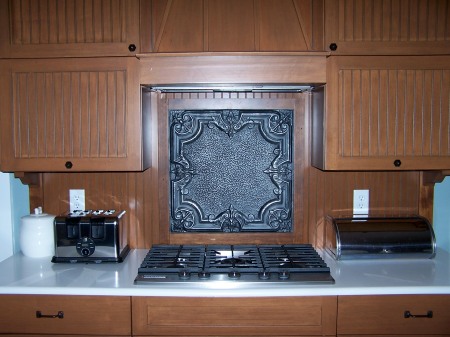
Backsplash close-up.
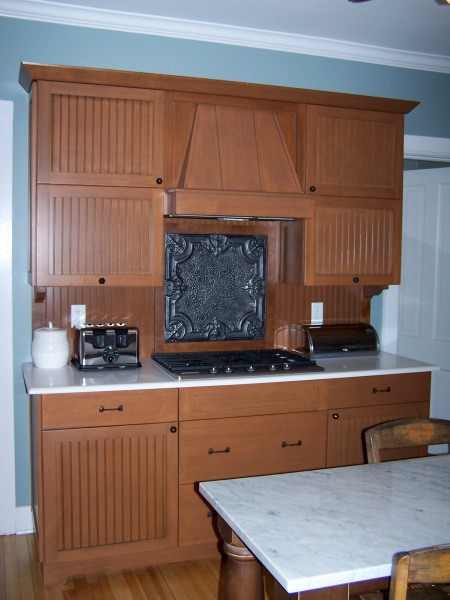
The hoosier, finished.
Here’s a little secret- the cabinet pulls are actually window pulls. We wanted the kitchen to as stay as true to the house as we could, and so we mimicked a lot of what can be found in other rooms. We have very similar bronze pulls on our sunporch windows and really liked the idea of putting window pulls on the doors. I myself am very drawn to the excesses of the Victorian Age, and often have to suppress the urge to ‘throw up’ Eastlake detail everywhere- an aesthetic our designer charmingly referred to as ‘Victorian vomit’. My husband, who prefers the more understated Victorian charm, is very good at talking me down from these Eastlake ledges. Thus he was able to coerce me away from the ridiculously carved Eastlake style pulls at Restoration Hardware.
While John’s favorite thing in the kitchen is the Hoosier, mine is hands-down the center table. We decided against an island in favor of this marble-toppedttable (at which I could still use my absolute favorite kitchen chairs, scavenged from the side of the road on the east side of Madison seven years ago):
This is perfect for the two of us to eat dinner here, without having to go into the formal dining room (which will just start the “we really need to do something with this room” conversation (as the dining room is the only room in the house that was subjected to popcorn paint, and neither of us know how we will remedy that yet…)and it’s perfect for rolling out doughs and fondant and for decorating in general, as I have somewhere to sit down in the kitchen.
We have also gotten the leaded glass window hung:
This window is special because it was taken from John’s childhood home. And I mean it when I say ‘taken’, as his parents removed it before they moved out because they loved it so- much to the new owners’ dismay. It then traveled around with them from house to house, until it made its way into our kitchen.
So, since we are finished, let me just do a quick before and after:
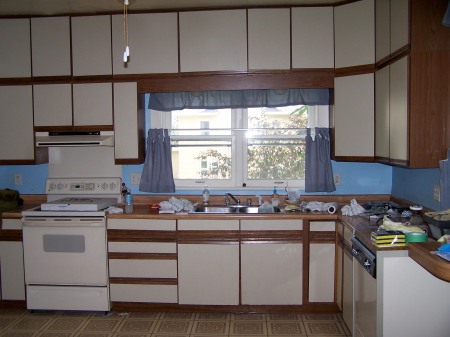
Before: East wall, August 2008.
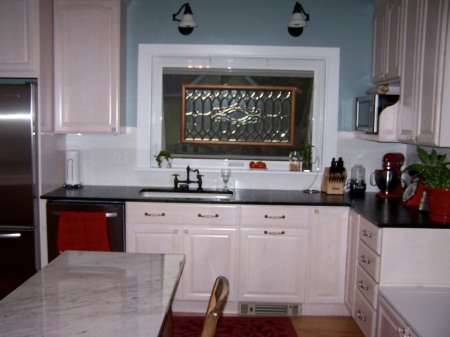
After: East wall, August 2009.
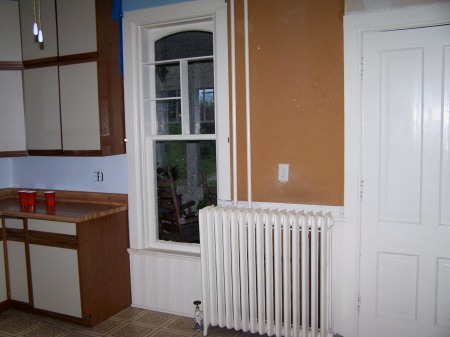
Before: South wall, August 2008.
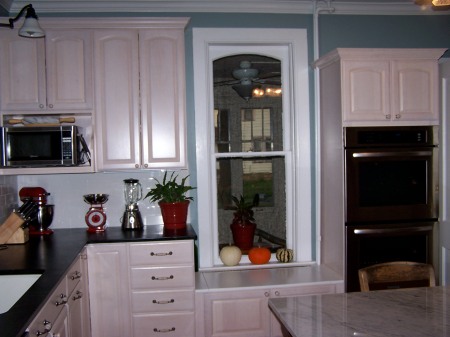
After: South wall, September 2009.
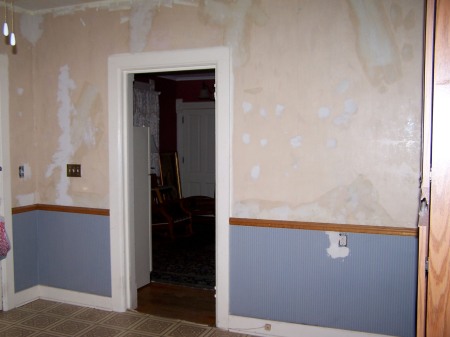
Before: West wall, 2008.
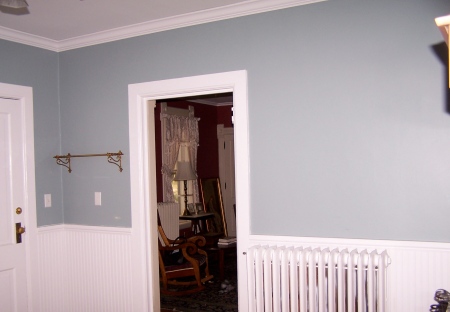
After: South Wall, September 2009.
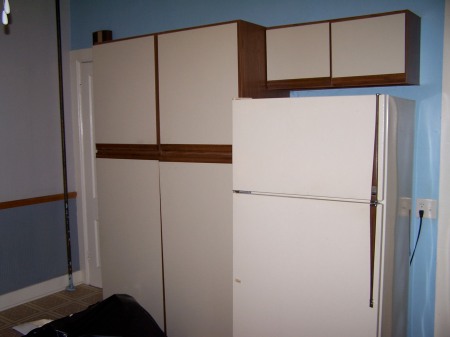
Before: North wall, August 2008.
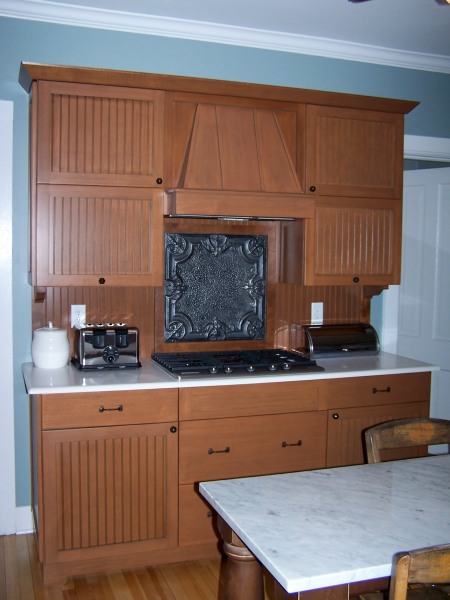
After: North wall, September 2009.
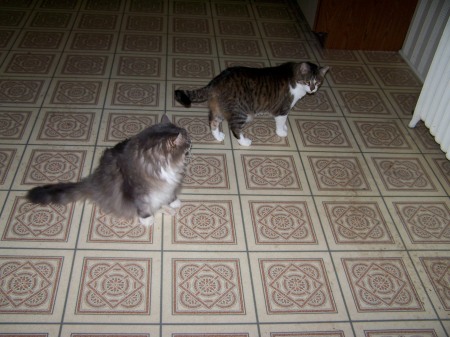
Before: Floor, 2008. RIP Bill.
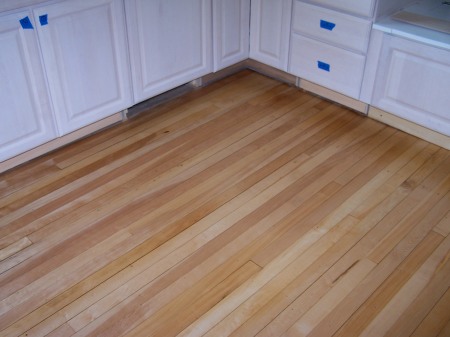
After: Floor, 2009.
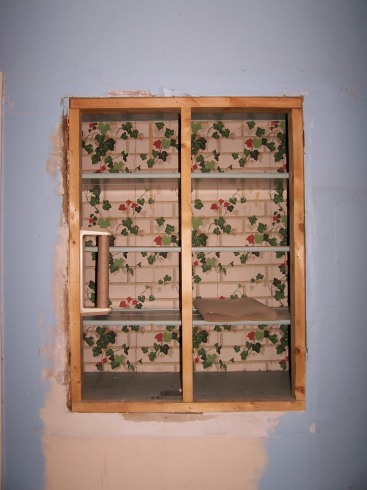









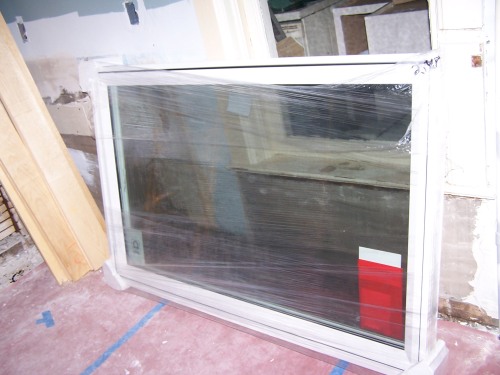
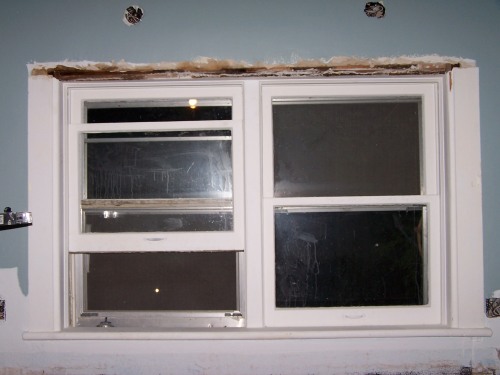



























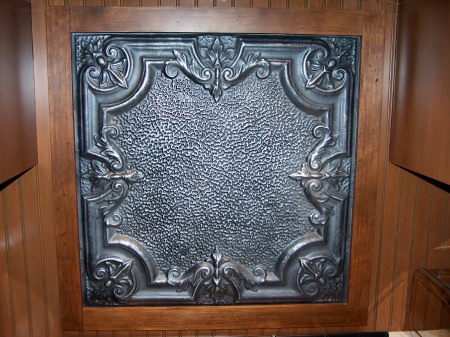


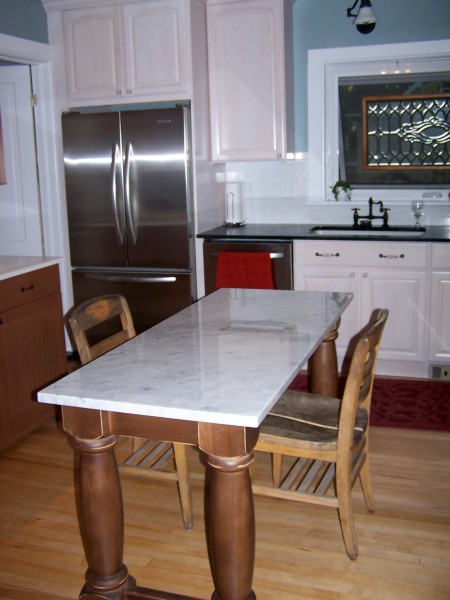
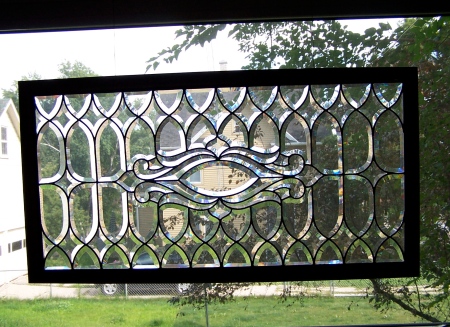
































0 comments:
Post a Comment